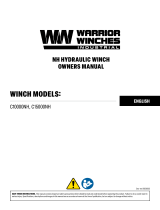Page is loading ...




Installation
Winches shown in this owner’s manual are solely and
exclusively designed for vehicle mounted, non-industrial
applications. Use in other applications will void warranty.
It is recommended that Ramsey Mounting Kits be used to
mount the winch. They are designed to align the winch and
distribute up to the full rated load correctly to avoid possible
damage to the winch or vehicle.
NOTE: If Ramsey Kits
are not used, the winch must be mounted to angles
(3/8” x 2 1/2” x 3” min) or in a frame with both sides
of the clutch housing and gear housing bolted to the
angles or frame.
See diagram below for recommended
mounting dimensions.
Note various thread depths of
mounting holes and use correspondingly different
bolt lengths for proper mounting.
Substitution of attaching hardware items (bolts, nuts, or
washers) different from those supplied with your winch
mounting kit can lead to failure causing damage or serious
injury. Use a socket head mounting bolt on side with Spur
Gear Housing (see diagram) to prevent clearance prob-
lems. Use SAE grade 5 bolts or better.
Electrical Connections and
Operations
For normal self recovery work, your existing electrical sys-
tem is adequate. Your battery must be kept in good
condition. A fully charged battery and proper connections
are essential. Run the vehicle engine during winching oper-
ation to keep battery charged.
Connect red cable from stud on plastic solenoid cover on
winch to positive battery terminal. Important: Hold inner nut
with end wrench while tightening outer nut.
Connect black cable from winch mounting bolt nearest
drum (as shown below) to negative battery terminal. A good
electrical ground is required for proper performance.
The remote control switch is water proof and has push but-
ton stations on either side. It is designed this way to
prevent quick winch reversals which lead to solenoid failure.
Make sure the winch motor has stopped fully before revers-
ing.
When first setting up your winch, follow the directions for
inserting the proper “IN” or “OUT” label in the thumb button.
The switch is also color coded to aid you in not having to
guess at the direction your winch will run.
Cable Installation
1. Unwind cable by rolling it out along the ground to pre-
vent kinking. Securely wrap end of cable, opposite hook,
with plastic or similar tape to prevent fraying.
2. Insert the end of the cable, opposite hook end, under
drum and into the 7/16” dia. hole in drum barrel. Secure
cable to drum barrel, using setscrew furnished with
winch.
Tighten setscrew securely.
3. Carefully run winch in the “reel-in” direction. Keeping
tension on end of cable, spool all the cable onto drum,
taking care to form neatly wrapped layers.
Inspect the cable frequently. If the cable becomes frayed
with broken strands, replace immediately. Cable and hook
assemblies may be purchased from a Ramsey distributor.
Operating Instructions
The RAM-LOK™ semi-automatic clutch provides free
spooling and clutch engagement with the cable drum. With
the clutch disengaged, the cable can be pulled off the drum
by hand. For winching in the load, the clutch must be fully
engaged with the drum.
To disengage the clutch, run the winch in the reverse (“reel
out”) direction until the load is off the cable and the cable
drum stops turning. Pull outward on the clutch handle,
rotate it counterclockwise 90° and release. The clutch is
now locked out and the cable may be pulled by hand.
(NOTE: if the clutch handle can not be pulled out, again
run the winch momentarily in reverse to relieve pressure on
the clutch jaws.)
WARNING: DO NOT ATTEMPT TO
DISENGAGE THE CABLE DRUM WHEN THERE IS A
LOAD ON THE CABLE.
To engage the clutch, pull outward on the handle, rotate it
clockwise 90° and release. Run the winch in reverse until
the clutch handle snaps fully in or until the cable drum
starts turning. At this point make sure the clutch handle is
all the way in. The plastic plug in top of clutch housing may
be removed, for inspection of clutch to assure total engage-
ment. After the clutch is fully engaged, the winch is ready
for winching in the cable.
Maintenance
Check monthly the action of the sliding clutch, making sure
it is fully engaging and disengaging with the cable drum.
With the clutch in the engaged position, remove the plastic
plug in top of the housing and observe if the clutch is fully
engaging. If clutch is not fully engaging, inspect the clutch
shifter assembly parts, check for damage or excessive wear
and replace as necessary. Observe the jaws on both the
clutch and cable drum, checking for rounding of the driving
faces. If rounding has occurred they should be replaced
immediately.
3/8-16 x .75"
7/16" DIA. CABLE
13.12 333,3
257,2
10.12
RE 12,000X
RE 8/10/12
MM ±.4
IN. ±.015
MODEL
"A" DIMENSION
CABLE ANCHOR HOLE
AT THIS LOCATION
TO WINCH USING MOUNTING BOLT
ATTACH BLACK GROUND CABLE
SIDE)
(EACH
THREADS
DEEP
3/8-16x1"
(EACH SIDE)
DEEP THREADS
28.5
1.12
63.5 MM
2.50 IN.
63.5 MM
2.50 IN.
A
WINCH INTO USE.
RELIEF FITTINGS BEFORE PUTTING
REMOVE RUBBER COVER FROM
188.8 MM
7.44 IN.
4








/




